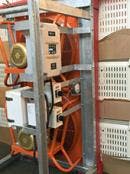Jet Precoolers plus plastic MacroBins equals a faster-cooling combination
Every year, more growers are changing to the use of plastic MacroBins and abandoning wooden field crates, for reasons including life-cycle costs, sanitation, and durability. Another benefit of the changeover is the ability to precool much faster in the new MacroBins than possible with the wooden design.
“For best-in-class precooling,” said Jim Still, president of Global Cooling Inc, manufacturer of the Jet Precooler, “you need the ‘Three Ps’. A great Precooler, of course, is first, and then you also need the proper Packaging, which is a close second—and finally you need to control the Process.”
“The reason the precooler comes first,” he said, “is that even with ‘non-cooperative’ packaging, we can at least precool thoroughly, even if it goes slowly. During the box or carton redesign process, many packers find they quickly can agree on a better box design, but before they can begin with it, they first have to use up three or four boxcar loads of the old corrugated.”
This can take a year or so, according to Still, and if you waited until the boxes were perfect to start precooling faster and better, “you’re tripping over dollars to pick up pennies. Our Jet Precoolers cost only about $500 a month on a lease plan, while new boxes are up in the five- and six-figure range,” said Still.
MacroBins are a product of MacroPlastics, which offers an Agriculture bin family designed with forced-air cooling in mind.
“Five percent air hole surface area in the box or bin sides perpendicular to air flow is ideal,” said Still, “and these airways have to extend all the way across the product, from air-entering-side to air-leaving-side.”
Corrugated boxes often are stacked two- or three-wide across a pallet, and air holes from box to box don’t always line up.
“So even if the box itself has, say 8% ventilation face area, the net effective airflow percentage is much lower than this, because the holes are blocked by adjacent packaging,” he said. “MacroBins can be near-perfect for forced-air precooling because the air pathways extend all the way across the product and bin.”
There are areas of the MacroBins, according to Still, where air can bypass the product.
“Short circuit is another way to describe this. Air is lazy, and seeks the path of least resistance, so it will flow into openings and gaps if they are present, leaving less air left to cool the fruit or vegetable.”
“This is part of the third ‘P’,” he said. “Your process has to include being sure these air bypasses are sealed off or blocked. With MacroBins, these areas are at the bottoms, if it is a four-way design, and then in between bins front to back—as with any other pallet or pallet equivalent—and in the headspace of the bins when product is not filled up to the very top.”
Strips of corrugated or pvc are usually used to seal off gaps.
“It is important to apply the seals after the tarp is down and the fans are turned on so that the fan suction holds all the seals in place,” said Still.
For more information, see www.PreCoolers.net.

